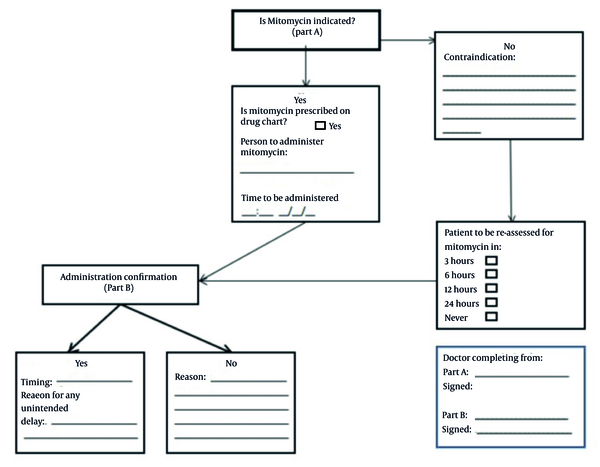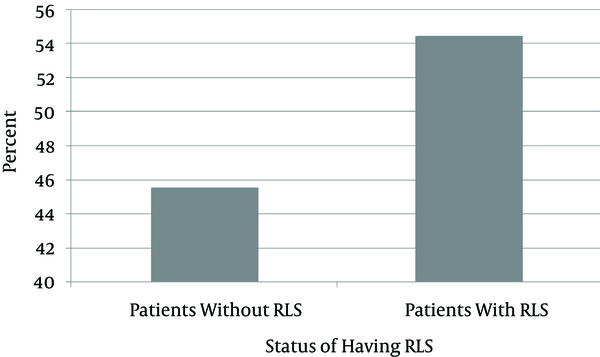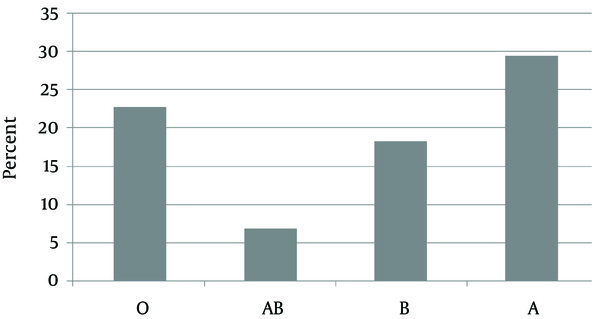Abstract
Background:
Sleep is one of the most fundamental human needs; without any doubt sleep is even more essential for sick patients, especially for patients with chronic illnesses. Sleep disturbance may lead to anxiety and reduced quality of life. Restless leg syndrome (RLS) is a sensory-motor disorder accompanied by a strong desire to move the legs or other parts of the body, which can cause sleep disturbance. Its etiology is unknown, but increased urea and creatinine levels before dialysis, iron deficiency due to kidney failure and end-stage renal disease (ESRD) are mentioned as causes.Objectives:
This study is designed to examine the prevalence of insomnia and restless leg syndrome in patients undergoing chronic hemodialysis in Rafsanjan Ali Ibn Abitaleb Hospital.Patients and Methods:
In this study we used two questionnaires to evaluate the presence of RLS and insomnia in ESRD patients who were undergoing hemodialysis treatment as kidney replacement therapy.Results:
According to our results, 54.5% of patients were diagnosed with RLS, and of those 65.2% and 42.9% were women and men, respectively. RLS is seen more often among patients with blood group type A, but this result was not statistically significant. There was a statistically significant correlation between RLS and a positive family history of RLS, between RLS and the number of hemodialysis treatments per week and also between RLS and the Insomnia Severity Index. Unlike previous studies, in this study we did not find any statistically significant correlation between RLS and biochemical factors such as serum iron, TIBC, BUN, creatinine, potassium, calcium and phosphorous levels.Conclusions:
The frequency of RLS among our patients was remarkable and we conclude that all patients who are undergoing hemodialysis should be screened for RLS, which can assist in providing proper attention and treatment.Keywords
1. Background
Sleep is known as one of the most fundamental needs of humans (1). People with sleep disorders not only suffer from fatigue but also have defects in cellular repair, impaired memory and learning, increased anxiety and reduced quality of life (2). Restless leg syndrome is a sensory-motor disorder, which occurs with a strong desire to move the legs or other parts of the body. This can be accompanied by discomfort, pain, tingling and numbness in the affected area that can be exacerbated by rest and inactivity (3). This syndrome has a prevalence of 2%–15% and is seen particularly in middle age and old age (4). The etiology of RLS is unknown, but idiopathic (primary) and secondary restless leg syndrome are two of the proposed pathophysiological mechanisms. Primary restless leg syndrome is a central nervous system disorder, with psychological factors and stress playing a role in its intensity (5, 6). Increased urea and creatinine levels before dialysis and iron deficiency due to kidney failure have been mentioned as causes of the disease (7). Other underlying conditions and diseases associated with RLS include iron deficiency (3), folate deficiency (8), kidney failure and end stage renal disease (ESRD) (3). An increased urea and creatinine before dialysis have been noted as possible causes of increase in frequency of this syndrome (9). In other studies, iron deficiency due to kidney failure has been a suggested cause (10, 11). A high frequency of family history is seen in this disease that suggests the existence of a genetic factor in the primary form of the disease (12, 13). This syndrome causes confusion and inability to rest, which has negative impacts on quality of life such as lack of comfort, sleep disorders, fatigue and stress and secondarily undermines the individual’s performance and impacts social and occupational activities, as well as family life (14). Sleep disorders, such as changes in sleep structure, sleep apnea syndrome, periodic limb movements, restless leg syndrome, insomnia and increased daily sleep can be seen more in patients on dialysis than the normal population (15-17). It seems that these disorders have a negative effect on quality of life in hemodialysis patients, as well as their clinical outcome (18-20). Recent studies have expressed a potential connection between sleep deprivation, lack of sleep, sleep disorders and an increased mortality and reduced quality of life (21-23). The evaluation and treatment of insomnia, as an effective criterion for quality of life, should be a priority, because this treatment can improve the quality of life and can be associated with important clinical outcomes. Insomnia can also be a warning sign and a criterion for diseases and mental disorders that indicate the necessity of considering insomnia as an indicator of underlying disease (24). In a study by Kazemi et al. performed on patients in the internal and surgical wards, 49.1% of the patients stated that their sleep quality was reduced (1). Use of medications and special care are the principles of this syndrome’s treatment (25).
2. Objectives
Recently, many studies in dialysis clinics based on finding an explanation for RLS risk factors have been conducted, but since these studies have been widely variable, this study is designed to examine the prevalence of insomnia and restless leg syndrome in patients undergoing chronic hemodialysis.
4. Results
Of 45 patients invited to participate, one refused to participate. Among the 44 patients who took part in this research project, 23 patients were women and 21 were men (Figure 1). The average score calculated for RLS in this population was 6.23±2.331, and according to the threshold (which was considered seven), 54.5% of participants were diagnosed with RLS (Figure 2).
Frequency of Gender of Study Participants

Frequency of Restless Leg Syndrome in Patients on Chronic Hemodialysis

Also, 29.5% of participants mentioned a family history of RLS. The average number of dialysis treatments per week in these patients was 2.51 ± 0.644. The most common blood group was group A, seen in13 patients and the least common was group AB, seen in three participants. Also, 88.2% of patients had a positive Rh blood group. Of the women who participated in this study, 65.2% had RLS, while this statistic was 42.9% for men. Although in accordance with results of this research and previous studies, the prevalence of this complication among women is higher than men, the difference is not significant (P < 0.05). Of patients with RLS, 29% had blood group A, blood group O constituted 23% of patients with RLS, and for blood groups B and AB this amount was much lower (Figure 3).
Frequency of Blood Groups in Patients Under Hemodialysis

Based on the results of this study, no significant correlation was found between the incidence of RLS and blood group. This result was also true for having RLS and the Rh blood group. Of the study participants, 29.5% reported a family history of RLS and 45.8% of this group had RLS. Also, it should be noted that 90% of those without a family history of RLS, did not have RLS. The association between RLS and family history was considerably significant (P < 0.05). There was no significant correlation between RLS and the factor of age or between the level of BUN, creatinine, calcium, potassium, phosphorus, iron or ferritin. However, the association between RLS and the number of dialysis treatments (P < 0.05) and the Insomnia Severity Index was significant (P < 0.01). Also, the Insomnia Severity Index and creatinine levels, as well as the number of dialysis treatments were significantly correlated (P < 0.05). We found no other significant relationship between the Insomnia Severity Index and other factors.
5. Discussion
The results of this study show a frequency of 54.5% for restless leg syndrome in patients on dialysis in Rafsanjan Ali Ibn Abitaleb Hospital, which is remarkable, whereas, this prevalence is reported as 28% by Kim et al. (29), 8.45% by Siddiqui S and colleagues in England (30), 10.18% by Curgunlu A and colleagues (31), 14.5% by Soyoral in Turkey (32) and 20.3% by Salman in Syria (33). The prevalence in some other areas was reported as follows: 22.96% in Central Serbia (34), 14% in Budapest (35), 21.5% in Italy (36), 1.5% to 6.6% in India (37, 38) and 14.8% in Brazil (39). In Iran, the reported prevalence by Salimi-Pour in Bushehr (7) (33.1%) and by Molla Hosseini in Tehran (61.5%) (40) was less than the result of the present study.
The result of this study did not show any relation between iron levels and restless leg syndrome and is congruent with Shahidi’s study (14) but does not match O’Keefe’s results (41). The type of patients under study, as Collado-Seidel verifies, can be a justifying factor (42).
This study showed that blood group can be associated with RLS, especially blood group type A. This result does not fit Shahidi’s study (14) that considered RLS related to the Rh blood group. According to this study, serum creatinine level was not correlated with restless leg syndrome, which is not consistent with Soyoral’s study (32) in Turkey. It can be concluded from this study that the occurrence of restless leg syndrome in patients on hemodialysis in Rafsanjan Ali Ibn Abitaleb Hospital is considerable. On the other hand, there is no significant relationship between blood biochemical factors such as iron, urea, calcium, phosphorus, potassium, creatinine, TIBC, TIBC/serum iron and restless leg syndrome. Thus, we concluded that all patients on chronic hemodialysis should be evaluated in terms of restless leg syndrome and effective therapeutic measures should be taken to improve their quality of life.
Acknowledgements
References
-
1.
Kazemi M, Rafiee G, Ansari A. Factors associated with sleep disorders among inpatients in the Surgical and internal units of Rafsanjan Educational and Therapeutic Center Ali Ibn Abi Talib (as), Rafsanjan University of Medical Sciences. [In Persion]. J Rafsanjan Univ Med Scie. 1384;4(4):270-5.
-
2.
Rezaeian M, Rad HS, Mostafavi SA, Fathinejad A, Ranjbar E, Bidaki R. Prevalence of sleep disorders in medical internship students of Rafsanjan University of Medical Sciences. Int Jclin surg adv. 2014;2(4):74-81.
-
3.
RLS Medical Bulletine . RLS Fudation. 2011. WWW.RLS.ORG.
-
4.
Rothdach AJ, Trenkwalder C, Haberstock J, Keil U, Berger K. Prevalence and risk factors of RLS in an elderly population: the MEMO study. Memory and Morbidity in Augsburg Elderly. Neurology. 2000;54(5):1064-8. [PubMed ID: 10720275].
-
5.
Allen RP, Picchietti D, Hening WA. Restless legs syndrome: diagnostic criteria, special considerations, and epidemiology. A report from the restless legs syndrome diagnosis and epidemiology workshop at the National Institutes of Health Sleep Med. 2003.
-
6.
Torkashvand F, Bagherian T, Abdolkarimi MA, Zarafshan H, Mostafavi SA, Bidaki R. Prevalence of Nocturnal Enuresis in School-age Children in Rafsanjan. J Pediat Nephrol. 2015;3(2):71-4.
-
7.
Salimi-Pour H, Azizi F, Motamed N, Tayebi N, DelavarKasmaee H, Karimi M. Restless leg syndrome in dialysis patients and its relationship with serum ferritin in Bushehr province. Southern Medical Quarterly. [In Persion]. Bushehr University of Medical Sciences and Health Services; 1388. p. 206-13.
-
8.
Lee KA, Zaffke ME, Baratte-Beebe K. Restless legs syndrome and sleep disturbance during pregnancy: the role of folate and iron. J Womens Health Gend Based Med. 2001;10(4):335-41. [PubMed ID: 11445024]. https://doi.org/10.1089/152460901750269652.
-
9.
Walker S, Fine A, Kryger MH. Sleep complaints are common in dialysis unit. Am J Kidney Dis. 1995;26(5):751-6.
-
10.
Mostafavi SA, Mohammadi MR, Hosseinzadeh P, Eshraghian MR, Akhondzadeh S, Hosseinzadeh-Attar MJ, et al. Dietary intake, growth and development of children with ADHD in a randomized clinical trialof Ritalin and Melatonin co-administration: Through circadian cycle modification or appetiteenhancement? Iran JPsychiatry. 2012;7(3):114-9.
-
11.
Roger SD, Harris DC, Stewart JH. Possible relation between restless legs and anemia in renal dialysis patients. Lancet. 1991;337(8756):1551.
-
12.
Chokroverty S, Jankovic J. Restless legs syndrome: a disease in search of identity. Neurology. 1999;52(5):907-10. [PubMed ID: 10102404].
-
13.
Winkelmann J, Muller-Myhsok B, Wittchen HU, Hock B, Prager M, Pfister H, et al. Complex segregation analysis of restless legs syndrome provides evidence for an autosomal dominant mode of inheritance in early age at onset families. Ann Neurol. 2002;52(3):297-302. [PubMed ID: 12205641]. https://doi.org/10.1002/ana.10282.
-
14.
Shahidi A, Abbaspoor S, Namjoo M, Najafzadeh A. Restless leg syndrome in hemodialysis patients of TorbatHeidariyeh ninth Dey hospital 1386. [In Persion]. 1386. p. 29-35.
-
15.
Pour MA, Mirzaei V, Bidaki R, Ghorbani AA, Mostafavi SA. The Frequency of Premature Ejaculation in Patients with Irritable Bowel Syndrome Govaresh. 2014;19(3):202-7.
-
16.
Merlino G, Piani A, Dolso P, Adorati M, Cancelli I, Valente M, et al. Sleep disorders in patients with end-stage renal disease undergoing dialysis therapy. Nephrol Dial Transplant. 2006;21(1):184-90. [PubMed ID: 16144846]. https://doi.org/10.1093/ndt/gfi144.
-
17.
Kosmadakis GC, Medcalf JF. Sleep disorders in dialysis patients. Int J Artif Organs. 2008;31(11):919-27. [PubMed ID: 19089793].
-
18.
Spiegel BM, Melmed G, Robbins S, Esrailian E. Biomarkers and health-related quality of life in end-stage renal disease: a systematic review. Clin J Am Soc Nephrol. 2008;3(6):1759-68. [PubMed ID: 18832106]. https://doi.org/10.2215/CJN.00820208.
-
19.
Liem YS, Bosch JL, Arends LR, Heijenbrok-Kal MH, Hunink MG. Quality of life assessed with the Medical Outcomes Study Short Form 36-Item Health Survey of patients on renal replacement therapy: a systematic review and meta-analysis. Value Health. 2007;10(5):390-7. [PubMed ID: 17888104]. https://doi.org/10.1111/j.1524-4733.2007.00193.x.
-
20.
Murtagh FE, Addington-Hall J, Higginson IJ. The prevalence of symptoms in end-stage renal disease: a systematic review. Adv Chronic Kidney Dis. 2007;14(1):82-99. [PubMed ID: 17200048]. https://doi.org/10.1053/j.ackd.2006.10.001.
-
21.
Benz RL, Pressman MR, Hovick ET, Peterson DD. Potential novel predictors of mortality in end-stage renal disease patients with sleep disorders. Am J Kidney Dis. 2000;35(6):1052-60.
-
22.
Winkelman JW, Chertow GM, Lazarus JM. Restless legs syndrome in end-stage renal disease. Am J Kidney Dis. 1996;28(3):372.
-
23.
Zoccali C, Mallamaci F, Tripepi G. Nocturnal hypoxemia predicts incident cardiovascular complications in dialysis patients. J Am Soc Nephrol. 2002;13(3):729-33. [PubMed ID: 11856778].
-
24.
Mohammadi MR, Mostafavi SA, Keshavarz SA, Eshraghian MR, Hosseinzadeh P, Hosseinzadeh-Attar MJ, et al. Melatonin effects in methylphenidate treated children with attention deficit hyperactivity disorder: a randomized double blind clinical trial. Iran J Psychiatry. 2012;7(2):87-92. [PubMed ID: 22952551].
-
25.
Thorpy M, Malow B, Ehrenber B, Phillips B. Restless leg syndrome detection and management in primary care. National center on sleep disorder. NIH Publication; 2000.
-
26.
Heidari A, Ehteshamzadeh P, Marashi D. The relationship between the severity of insomnia, sleep quality, sleepiness and impaired mental health and academic performance of girls. Journal - of women and culture [in Persian]. 1389;1(4):65-76.
-
27.
Dehghan N, Ghanei R, Rezaei K. Restless legs syndrome is related to the quality of sleep disturbance in pregnant women. J Obstetrics Gynecolog Infer Iran. 2012;15(15):1-7.
-
28.
American Psychiatric Association's. The Diagnostic and Statistical Manual of Mental Disorders fifth edition (DSM-5). p. 410-3.
-
29.
Kim JM, Kwon HM, Lim CS, Kim YS, Lee SJ, Nam H. Restless legs syndrome in patients on hemodialysis: symptom severity and risk factors. J Clin Neurol. 2008;4(4):153-7. [PubMed ID: 19513290]. https://doi.org/10.3988/jcn.2008.4.4.153.
-
30.
Siddiqui S, Kavanagh D, Traynor J, Mak M, Deighan C, Geddes C. Risk factors for restless legs syndrome in dialysis patients. Nephron Clin Pract. 2005;101(3):c155-60. [PubMed ID: 16020954]. https://doi.org/10.1159/000087073.
-
31.
Curgunlu A, Doventas A, Karadeniz D, Erdincler DS, Ozturk AK, Karter Y, et al. Prevalence and characteristics of restless legs syndrome (RLS) in the elderly and the relation of serum ferritin levels with disease severity: hospital-based study from Istanbul, Turkey. Arch Gerontol Geriatr. 2012;55(1):73-6. [PubMed ID: 21722973]. https://doi.org/10.1016/j.archger.2011.06.002.
-
32.
Soyoral Y, Sayarlioglus H, Tuncel D, Sahin M, Dogan E, Erkoc R. Prevalence and risk factors of restless leg syndrome in a single hemodialysis unit. Turk J Med Sci. 2010;40(3):443-6.
-
33.
Salman SM. Restless legs syndrome in patients on hemodialysis. Saudi J Kidney Dis Transpl. 2011;22(2):368-72. [PubMed ID: 21422649].
-
34.
Nikic PM, Andric BR, Stojanovic-Stanojevic M, Dordevic V, Petrovic D, Stojimirovic BB. [Restless legs syndrome prevalence in patients on chronic hemodialysis in central Serbia]. Vojnosanit Pregl. 2007;64(2):129-34. [PubMed ID: 17348465].
-
35.
Mucsi I, Molnar MZ, Ambrus C, Szeifert L, Kovacs AZ, Zoller R, et al. Restless legs syndrome, insomnia and quality of life in patients on maintenance dialysis. Nephrol Dial Transplant. 2005;20(3):571-7. [PubMed ID: 15671074]. https://doi.org/10.1093/ndt/gfh654.
-
36.
Gigli GL, Adorati M, Dolso P, Piani A, Valente M, Brotini S, et al. Restless legs syndrome in end-stage renal disease. Sleep Med. 2004;5(3):309-15. [PubMed ID: 15165541]. https://doi.org/10.1016/j.sleep.2004.01.014.
-
37.
Bhowmik D, Bhatia M, Tiwari S, Mahajan S, Gupta S, Agarwal SK, et al. Low prevalence of restless legs syndrome in patients with advanced chronic renal failure in the Indian population: a case controlled study. Ren Fail. 2004;26(1):69-72. [PubMed ID: 15083925].
-
38.
Bhowmik D, Bhatia M, Gupta S, Agarwal SK, Tiwari SC, Dash SC. Restless legs syndrome in hemodialysis patients in India: a case controlled study. Sleep Med. 2003;4:143-6.
-
39.
Goffredo Filho GS, Gorini CC, Purysko AS, Silva HC, Elias IE. Restless legs syndrome in patients on chronic hemodialysis in a Brazilian city: frequency, biochemical findings and comorbidities. Arq Neuropsiquiatr. 2003:723-7.
-
40.
MollaHosseini S, Mohammadzadeh S, Kamali P, TavakoliShooshtari M, editors. Prevalence of sleep disorders and Restless leg syndrome in patients referred to hemodialysis units of hospitals affiliated to Tehran University of Medical Sciences. [In Persian]. Year 15; Medical Science Journal of Islamic Azad University. p. 27-30.
-
41.
O'Keeffe ST. Iron deficiency with normal ferritin levels in restless legs syndrome. Sleep Med. 2005;6(3):281-2. [PubMed ID: 15854860]. https://doi.org/10.1016/j.sleep.2004.10.008.
-
42.
Collado-Seidel V, Kohnen R, Samtleben W, Hillebrand GF, Oertel WH, Trenkwalder C. Clinical and biochemical findings in uremic patients with and without restless legs syndrome. Am J Kidney Dis. 1998;31(2):324-8. [PubMed ID: 9469505].